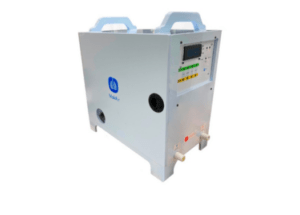
In a blog post April 17, Parrot announced that they are supporting the French medical profession by contributing their experience in engine design and integration to the MakAir open source respirator project. “The engine is an essential and very demanding part of any ventilation device: constant power, controlled vibrations, sufficient reliability and endurance to allow 24/24 operation for 6 weeks,” says Parrot. “Our expertise allows us to offer today 500 engines that perfectly meet these criteria, for the launch of the MakAir project, which is both ambitious, simple and modular.”
MakAir
The sheer volume of Covid-19 victims has highlighted a worldwide shortage of artificial respirators, which are required for treating the most severe cases.
Countries all over the world have struggled to increase production in time to meet the needs of the current crisis. In France, an Air Liquide project aimed to increase the production of artificial respirators from 200 to 10,000 per year, starting in May 2020: a second nonprofit project has spurred initiatives to create a simplified artificial respirator from standard components to help alleviate the shortage as soon as possible.
“Quentin Adam of the Makers For Life collective, in collaboration with Professors Antoine Roquilly and Pierre-Antoine Gourraud of the Faculty of Medicine of Nantes, and Erwan L’Her, Head of the Intensive Medicine and Care Department of the Brest CHU, proposed a concept innovative simplified artificial respirator, based on a software regulation of inspiration- expiration, directly from the pneumatic system (and not from electromechanical ventilators),” says the Parrot blog post. “This architecture makes it possible to simplify the very complex management of the lungs under Covid-19, to dispense with multiple measurements and displays, and to use fans and standard components.”
Drones for Coronavirus Response
Other manufacturers have also stepped up in the crisis. DJI is providing drones for coronavirus response to law enforcement and public service departments. Many public safety departments have begun using drones to monitor social distancing. Drones have also been used in China to disinfect public spaces: and delivery drones are being used to make contactless delivery of critical supplies in both China and the U.S.
Miriam McNabb is the Editor-in-Chief of DRONELIFE and CEO of JobForDrones, a professional drone services marketplace, and a fascinated observer of the emerging drone industry and the regulatory environment for drones. Miriam has penned over 3,000 articles focused on the commercial drone space and is an international speaker and recognized figure in the industry. Miriam has a degree from the University of Chicago and over 20 years of experience in high tech sales and marketing for new technologies.
For drone industry consulting or writing, Email Miriam.
TWITTER:@spaldingbarker
Subscribe to DroneLife here.